
The Red Spider Nebula is a planetary nebula located near the heart of the Milky Way, in the northwest of the constellation Sagittarius. The nebula has a prominent two-lobed shape, possibly due to a binary companion or magnetic fields and has an S-shaped symmetry of the lobes – the lobes opposite each other appear similar. This is believed to be due to the presence of a companion to the central white dwarf. However, the gas walls of the two lobed structures are not at all smooth, but rather are rippled in a complex way.

Astronomy Picture of the Day (APOD) is a website provided by NASA and Michigan Technological University (MTU). According to the website, "Each day a different image or photograph of our universe is featured, along with a brief explanation written by a professional astronomer." The photograph does not necessarily correspond to a celestial event on the exact day that it is displayed, and images are sometimes repeated. However, the pictures and descriptions often relate to current events in astronomy and space exploration. The text has several hyperlinks to more pictures and websites for more information. The images are either visible spectrum photographs, images taken at non-visible wavelengths and displayed in false color, video footage, animations, artist's conceptions, or micrographs that relate to space or cosmology. Past images are stored in the APOD Archive, with the first image appearing on June 16, 1995. This initiative has received support from NASA, the National Science Foundation, and MTU. The images are sometimes authored by people or organizations outside NASA, and therefore APOD images are often copyrighted, unlike many other NASA image galleries.
John Alexander Davis is an American film director, writer, animator, voice actor and composer known for his work both in stop-motion animation as well as computer animation, live action and live-action/CGI hybrids. Davis is best known for co-creating Nickelodeon's Jimmy Neutron franchise, which enjoyed popularity in the early to mid 2000s.

NGC 1300 is a barred spiral galaxy located about 61 million light-years away in the constellation Eridanus. The galaxy is about 110,000 light-years across. It is a member of the Eridanus Cluster, a cluster of 200 galaxies. It was discovered by John Herschel in 1835.

NGC 1532, also known as Haley's Coronet, is an edge-on barred spiral galaxy located approximately 50 million light-years from the Solar System in the constellation Eridanus. The galaxy was discovered by James Dunlop on 29 October 1826.

NGC 1531 is a dwarf galaxy in the constellation Eridanus that is interacting with the larger spiral galaxy NGC 1532. It was discovered by John Herschel on 19 October 1835. Although technically classified as a peculiar lenticular galaxy, the galaxy's structure is better described as amorphous.

NGC 3370 (also known as UGC 5887 or Silverado Galaxy) is a spiral galaxy about 98 million light-years away in the constellation Leo. It is comparable to our Milky Way both in diameter (100,000 light years) and mass (1011 solar masses). NGC 3370 exhibits an intricate spiral arm structure surrounding a poorly defined nucleus. It is a member of the NGC 3370 Group of galaxies, which is a member of the Leo II Groups, a series of galaxies and galaxy clusters strung out from the right edge of the Virgo Supercluster.
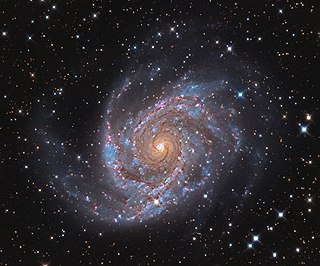
NGC 2997 is a face-on unbarred spiral galaxy about 40 million light-years away in the faint southern constellation of Antlia. It was discovered March 4, 1793 by German-born astronomer William Herschel. J. L. E. Dreyer described it as, "a remarkable object, very faint, very large, very gradually then very suddenly bright middle and 4 arcsec nucleus. This is the brightest galaxy of the NGC 2997 group of galaxies, and was featured on the cover of the first edition of Galactic Dynamics by James Binney and Scott Tremaine.

NGC 1818 is a young globular cluster in the north-west part of the Large Magellanic Cloud, about 3.2 kpc from the center. It was discovered by Scottish astronomer James Dunlop in 1826, and has since been well studied.
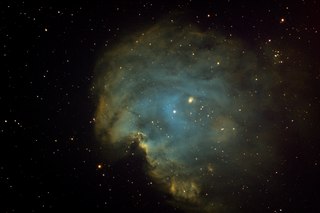
NGC 2174 is an H II emission nebula located in the constellation Orion and is associated with the open star cluster NGC 2175. It is thought to be located about 6,400 light-years away from Earth. The nebula may have formed through hierarchical collapse.

NGC 7635, also known as the Bubble Nebula, Sharpless 162, or Caldwell 11, is an H II region emission nebula in the constellation Cassiopeia. It lies close to the direction of the open cluster Messier 52. The "bubble" is created by the stellar wind from a massive hot, 8.7 magnitude young central star, SAO 20575 (BD+60°2522). The nebula is near a giant molecular cloud which contains the expansion of the bubble nebula while itself being excited by the hot central star, causing it to glow. It was discovered in 1787 by William Herschel. The star BD+60°2522 is thought to have a mass of about 44 M☉.
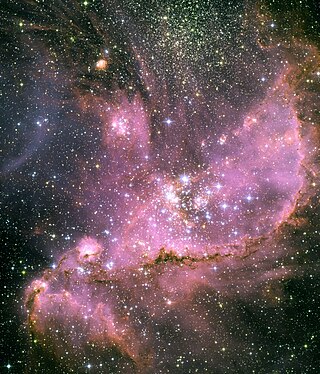
NGC 346 is a young open cluster of stars with associated nebula located in the Small Magellanic Cloud (SMC) that appears in the southern constellation of Tucana. It was discovered August 1, 1826 by Scottish astronomer James Dunlop. J. L. E. Dreyer described it as, "bright, large, very irregular figure, much brighter middle similar to double star, mottled but not resolved". On the outskirts of the cluster is the multiple star system HD 5980, one of the brightest stars in the SMC.

NGC 290 is an open cluster of stars in the southern constellation of Tucana. This cluster was discovered September 5, 1826 by Scottish astronomer James Dunlop. It lies some 200,000 light years away from the Sun in the Small Magellanic Cloud galaxy. The cluster is an estimated 30–63 million years old and is around 65 light years across.

NGC 265 is an open cluster of stars in the southern constellation of Tucana. It is located in the Small Magellanic Cloud, a nearby dwarf galaxy. The cluster was discovered by English astronomer John Herschel on April 11, 1834. J. L. E. Dreyer described it as, "faint, pretty small, round", and added it as the 265th entry in his New General Catalogue.

NGC 1893 is an open cluster in the constellation Auriga. It is about 12,400 light years away. The star cluster is embedded in the HII region IC 410.
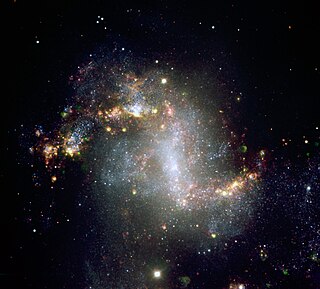
NGC 1313 is a field galaxy and a barred spiral galaxy discovered by the Scottish astronomer James Dunlop on 27 September 1826. It has a diameter of about 50,000 light-years, or about half the size of the Milky Way.

NGC 474 is an elliptical galaxy about 100 million light years distant in the constellation Pisces. This large galaxy is known to possess tidal shells and tidal tails, although their origins remain unclear. One possible explanation is that NGC 474 interacted with a galaxy several billion years ago.

NGC 6559 is a star-forming region located at a distance of about 5000 light-years from Earth, in the constellation of Sagittarius, showing both emission (red) and reflection (bluish) regions.
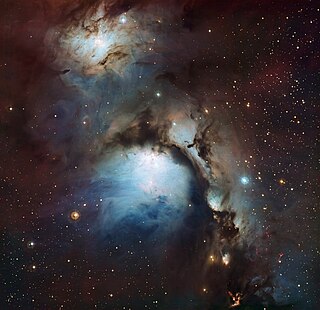
NGC 2071 is a reflection nebula in the constellation Orion. It was discovered on January 1, 1784, by William Herschel. It is part of a group of nebulae that also includes Messier 78, NGC 2064, and NGC 2067.

NGC 4731 is a barred spiral galaxy located near the Virgo supercluster. To its celestial south lies NGC 4731A, a small irregular galaxy. Both galaxies feature high concentrations of neutral HI gas. It is theorized that its elongated arm structure could be related to gravitational interactions with a nearby galaxy, NGC 4967. It is a member of the NGC 4697 Group of galaxies, which is a member of the Virgo II Groups, a series of galaxies and galaxy clusters strung out from the southern edge of the Virgo Supercluster.


















